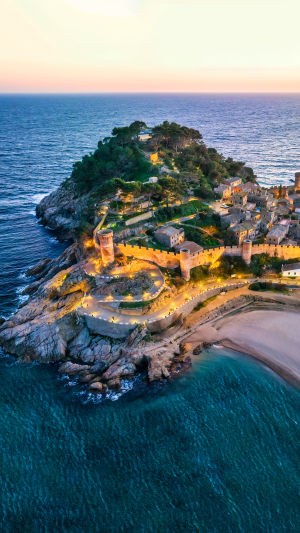Tossa de Mar in Costa Brava is a serene beach getaway ideal for families. It offers pristine beaches by the sea and charming walks through its historic 14th-century old town. Additionally, this picturesque Mediterranean town promises delightful culinary experiences.
Nestled at the base of a bay between cliffs, the town center and main beach boast crystal clear waters and bustling marine life, making it a sought-after destination for divers, including those from Barcelona.
<h3>Things to do in Tossa de Mar</h3>
The natural beauty of the seaside is a major draw for visitors to Tossa de Mar. The stunning Mediterranean landscape provides breathtaking scenery for hiking and various outdoor activities. Additionally, the medieval town center offers intriguing historical sites to explore, creating a charming contrast to the natural splendor.
<b>1. Vila Vella</b>
Vila Vella, meaning "old village," is the fortified part of Tossa de Mar. Over time, the rectangular castle, topped with a watchtower, has evolved into today's lighthouse.
Inside Vila Vella, charming narrow cobbled streets wind through the area. The remains of the late-Gothic 15th-century building of Sant Vicenç are also found within Vila Vella, built upon the foundations of an earlier Romanesque building from the 11th or 12th century. The 300-meter-long rampart surrounding the old town is an iconic feature of Tossa de Mar, offering unparalleled views from its summit.
<b>2. Museu Municipal de Tossa de Mar</b>
Since 1935, the municipal museum has been located in the Old Town. It is divided into two main sections: arts and archaeology. The arts section showcases collections by various artists including Marc Chagall and Olga Sacharoff. In the archaeological section, visitors can explore the ruins of the Ametllers Villa from the 2nd century BC, one of the significant Roman villas discovered in the Tarragona Province. The entry fee is about 3€.
<h3>How to get to Tossa de Mar</h3>
<b>From Barcelona Airport</b>, there are a few direct buses to Tossa de Mar each day during the summer months, with the journey taking over 2 hours.
<b>If you're traveling from Barcelona City</b>, buses to Tossa de Mar depart from Estació del Nord, the main bus station located just over one kilometer from Catalonia Square near the Arc de Triomf metro station.
For train connections from Barcelona heading north toward Costa Brava, the railway only goes as far as Blanes before turning inland. The distance from Blanes to Tossa de Mar is 18 kilometers.
<b>From Girona Airport</b>, there are a couple of daily direct buses to Tossa de Mar, taking about 35 minutes. Alternatively, more frequent buses operate from Girona Airport to Lloret de Mar, where you can transfer to a local bus for the 10-kilometer journey to Tossa de Mar.
<h3>Weather in Tossa de Mar</h3>
<b>Winter in Tossa de Mar is mild</b>, with average daily highs ranging from 5°C to 15°C, and frequent rainfall.
<b>During spring</b>, particularly in March and April, temperatures can exceed 20°C, but mornings and evenings can still be chilly, so it's advisable to carry a coat. The seawater remains too cold for swimming early in the season, but rain is less frequent compared to winter. By May, temperatures consistently rise above 20°C, and beaches start to attract sunbathers.
<b>Summer, especially June</b>, is an ideal time to visit Tossa de Mar, with daytime temperatures reaching up to 30°C. July and August are the hottest and driest months, with temperatures sometimes soaring to 35°C in the shade.
<b>Autumn begins with warm temperatures</b> both on land and in the sea, allowing beach activities to continue into early October. As the season progresses, temperatures gradually drop below 20°C, and rainfall increases.
As you plan your visit to Tossa de Mar, we hope this guide has sparked your curiosity about this serene Mediterranean gem.
We'd love to hear about your experiences and tips for exploring this beautiful town. Share your thoughts and photos with us—Lykkers, let's continue the conversation and inspire each other's adventures in Tossa de Mar!





